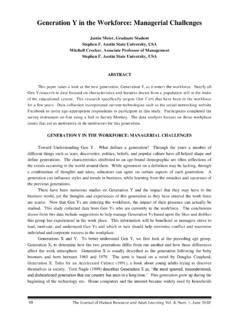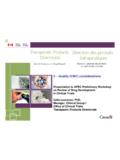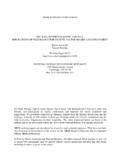Transcription of GUIDELINES ON STABILITY EVALUATION OF …
1 WHO/ - Final ENGLISH ONLY GUIDELINES ON STABILITY EVALUATION OF VACCINES World Health Organization 2006 All rights reserved. Publications of the World Health Organization can be obtained from WHO Press, World Health Organization, 20 Avenue Appia, 1211 Geneva 27, Switzerland (tel.: +41 22 791 3264; fax: +41 22 791 4857; e-mail: Requests for permission to reproduce or translate WHO publications whether for sale or for noncommercial distribution should be addressed to WHO Press, at the above address (fax: +41 22 791 4806; e-mail: The designations employed and the presentation of the material in this publication do not imply the expression of any opinion whatsoever on the part of the World Health Organization concerning the legal status of any country, territory, city or area or of its authorities, or concerning the delimitation of its frontiers or boundaries.))
2 Dotted lines on maps represent approximate border lines for which there may not yet be full agreement. The mention of specific companies or of certain manufacturers products does not imply that they are endorsed or recommended by the World Health Organization in preference to others of a similar nature that are not mentioned. Errors and omissions excepted, the names of proprietary products are distinguished by initial capital letters. All reasonable precautions have been taken by the World Health Organization to verify the information contained in this publication. However, the published material is being distributed without warranty of any kind, either expressed or implied.
3 The responsibility for the interpretation and use of the material lies with the reader. In no event shall the World Health Organization be liable for damages arising from its use. The named authors [editors] alone are responsible for the views expressed in this publication. Adopted by the 57th meeting of the WHO Expert Committee on Biological Standardization, 23-27 October 2006. A definitive version of this document, which will differ from this version in editorial but not scientific details, will be published in the WHO Technical Report Series. WHO/ - Final Page 2 Table of Contents 1.
4 2. Scope ..4 3. Glossary ..4 4. General consideration ..7 5. STABILITY EVALUATION at different stages of production and use ..8 Choice of STABILITY indicating parameters and frequency testing ..9 Intermediates ..10 Cumulative age of an antigen in the final product ..10 Final lot ..11 6. STABILITY EVALUATION of vaccines: regulatory considerations ..12 STABILITY studies for clinical trial approval ..13 STABILITY EVALUATION for licensing ..13 Post-licensure STABILITY monitoring ..15 STABILITY testing for lot release.
5 15 7. Design of studies and statistical considerations ..16 Statistical considerations in vaccine STABILITY study design ..16 Selection and testing of samples ..17 Assays employed in STABILITY studies and the expression of results ..17 Design of studies in support of product licensure ..18 Design of ongoing monitoring of post licensure STABILITY ..19 Design of STABILITY studies and analysis of the data to support manufacturing changes ..19 8. Data analysis ..21 Comparing STABILITY study measurements to an acceptance criterion.
6 21 Estimation of STABILITY parameters, including variability in STABILITY estimates ..21 Calculation of expiry period and/or minimum release potencies ..21 Analysis of post licensure STABILITY study data ..22 9. STABILITY EVALUATION of combined vaccines ..23 10. Labelling ..24 References ..27 WHO/ Page 3 1. Introduction WHO recommendations and GUIDELINES for production and control of vaccines and other biologicals are scientific and advisory in nature and provide guidance for national regulatory authorities and for vaccine manufacturers ( ). They form the basis for the acceptability of products globally.
7 These recommendations feature STABILITY as an important element and provide guidance for STABILITY testing for individual vaccines. The following text is written in the form of GUIDELINES instead of recommendations in view of the facts that vaccines represent a heterogeneous class of agents, and the STABILITY testing will need to be adapted for the product in question. GUIDELINES allow greater flexibility than Recommendations with respect to specific issues related to particular vaccines. The STABILITY of vaccines has a major impact on the success of immunization programmes worldwide.
8 As part of its efforts to assure vaccine quality, WHO has acknowledged the importance of clearly defining the STABILITY characteristics of a vaccine and emphasizes the role of national regulatory authorities in overall vaccine EVALUATION . The aim of this document is to provide the scientific basis and guiding principles for EVALUATION of vaccine STABILITY for the purpose of clinical trial approval, licensing, and post-licensure monitoring. The temperature sensitivity of vaccine characteristics, particularly potency, led to the development of storage and cold chain requirements for all vaccines.
9 In the 1980s and the beginning of the 1990s, a major WHO focus was on thermostability testing as measured by potency assays, as part of lot release. More recently, guidance has addressed the importance of studies performed under real storage conditions, real time and other relevant environmental factors. In addition, the WHO GUIDELINES for nonclinical and clinical EVALUATION of vaccines, stress a need for STABILITY data to support clinical trial approval ( 1, 2). However, until now there has been no comprehensive guidance document available which deals with the STABILITY EVALUATION of vaccines at different stages of vaccine development, production, licensing, lot release and post-licensing studies.
10 At its 51st meeting the Expert Committee on Biological Standardization recommended that WHO set up a working group on STABILITY EVALUATION of vaccines to take this issue forward. The first meeting of the working group was held at the Paul-Ehrlich Institute, in Langen, Germany, in February 2002, when key issues to be included in a guideline were identified. At its second meeting, held at WHO, Geneva, in 2004, the working group suggested further additions and improvements to the proposed GUIDELINES including guidance on the design of STABILITY studies. Reviews of STABILITY studies undertaken on different types of vaccines were carried out in 2004 and 2005.

















